2014 Peugeot 308 trailer
[x] Cancel search: trailerPage 5 of 400

Contents
308_EN_CHAP00A _SOMMAIRE_ED02-2013
M i r r o r s 170
Lighting 173
Daytime running lamps 177
Automatic illumination of headlamps 178
Headlamp adjustment 180
Wipers 181
Automatic rain sensitive wipers 183
Courtesy lamps 185
Interior mood lighting 186
Temporary puncture repair kit 221
Changing a wheel 227
Snow chains 234
Changing a bulb 235
Changing a fuse 245
12 V battery 251
Energy economy mode 255
Changing a wiper blade 256
Towing the vehicle 257
Very cold climate screen 259
Towing a trailer 260
Fitting roof bars 262
Accessories 264
Bonnet 267
Petrol engine 268
Diesel engine 269
Running out of fuel (Diesel) 270
Additif AdBlue® additive and SCR system ® additive and SCR system ®
(Blue HDi Diesel) 271
Checking levels 280
Checks 283
Engines 285
Weights 285
Dimensions 286
Identifi cation markings 287
Direction indicators 187
Hazard warning lamps 187
Emergency or assistance call 188
Horn 188
Tyre under-infl ation detection 189
ESC system 193
Seat belts 196
Airbags 199
Child seats 204
Deactivating the passenger's front airbag 207
ISOFIX child seats 213
Child lock 220
Visibility
Safety Practical information
Checks Technical data
.
Emergency or assistance
289
DENON equipment 291
Touch screen 293
PEUGEOT Connect Sound (RD5) 365
Audio equipment and telematics
Alphabetical index
Page 13 of 400
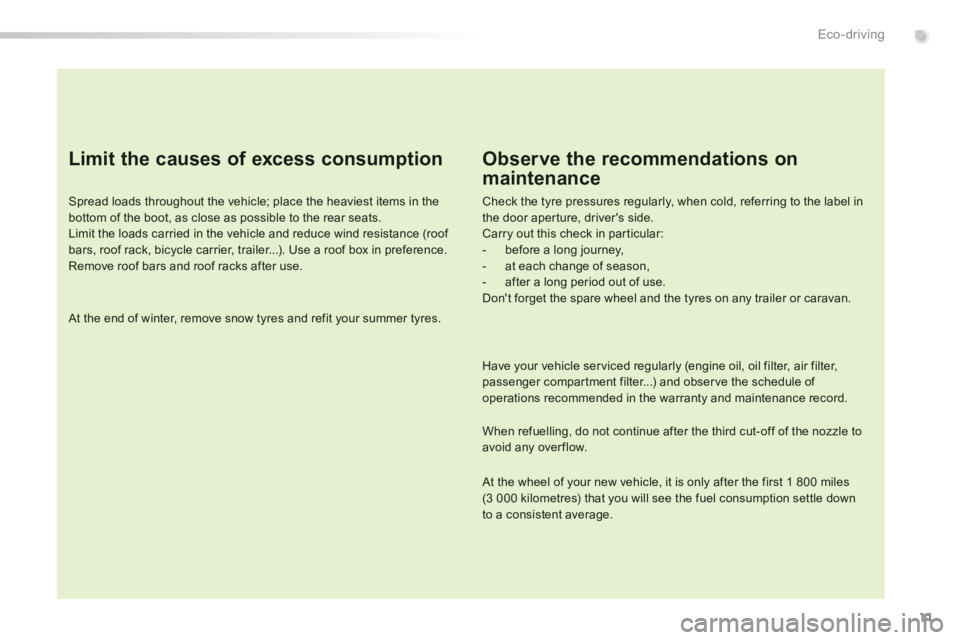
11
.Eco-driving
308_EN_CHAP00C_ECO CONDUITE_ED02-2013
Limit the causes of excess consumption
Spread loads throughout the vehicle; place the heaviest items in the bottom of the boot, as close as possible to the rear seats. Limit the loads carried in the vehicle and reduce wind resistance (roof bars, roof rack, bicycle carrier, trailer...). Use a roof box in preference. Remove roof bars and roof racks after use.
At the end of winter, remove snow tyres and refit your summer tyres.
Observe the recommendations on
maintenance
Check the tyre pressures regularly, when cold, referring to the label in the door aperture, driver's side. Carry out this check in particular: - before a long journey, - at each change of season, - after a long period out of use. Don't forget the spare wheel and the tyres on any trailer or caravan.
Have your vehicle serviced regularly (engine oil, oil filter, air filter, passenger compartment filter...) and observe the schedule of operations recommended in the warranty and maintenance record.
When refuelling, do not continue after the third cut-off of the nozzle to avoid any over flow.
At the wheel of your new vehicle, it is only after the first 1 800 miles (3 000 kilometres) that you will see the fuel consumption settle down to a consistent average.
Page 159 of 400
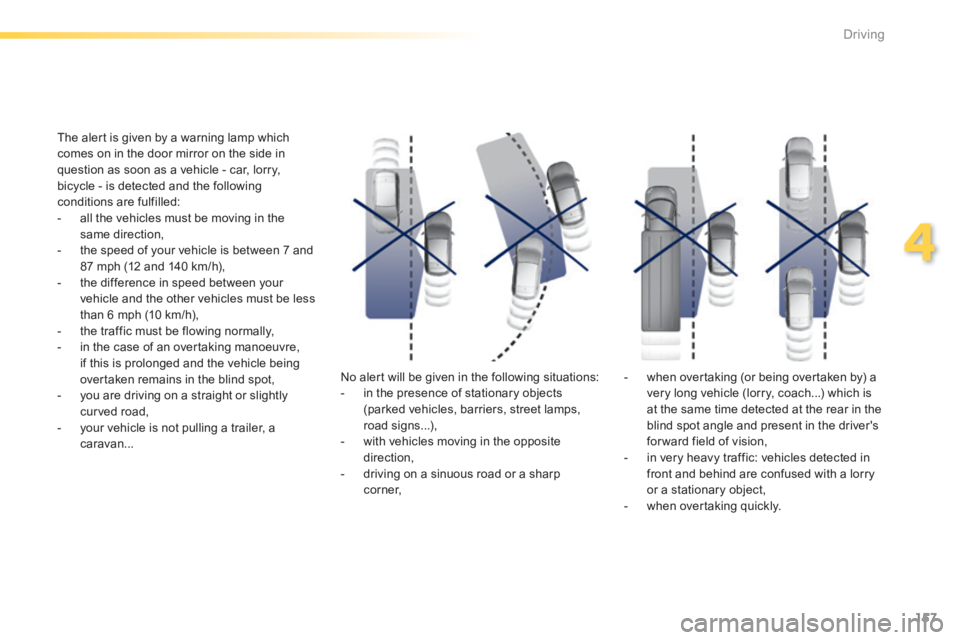
157
4
Driving
308_EN_CHAP04_CONDUITE_ED02-2013
The alert is given by a warning lamp which comes on in the door mirror on the side in question as soon as a vehicle - car, lorry, bicycle - is detected and the following conditions are fulfilled: - all the vehicles must be moving in the same direction, - the speed of your vehicle is between 7 and 87 mph (12 and 140 km/h), - the difference in speed between your vehicle and the other vehicles must be less than 6 mph (10 km/h), - the traffic must be flowing normally, - in the case of an overtaking manoeuvre, if this is prolonged and the vehicle being overtaken remains in the blind spot, - you are driving on a straight or slightly curved road, - your vehicle is not pulling a trailer, a caravan...
No alert will be given in the following situations: - in the presence of stationary objects (parked vehicles, barriers, street lamps, road signs...), - with vehicles moving in the opposite direction, - driving on a sinuous road or a sharp c o r n e r,
- when overtaking (or being overtaken by) a very long vehicle (lorry, coach...) which is at the same time detected at the rear in the blind spot angle and present in the driver's for ward field of vision, - in very heavy traffic: vehicles detected in front and behind are confused with a lorry or a stationary object, - when overtaking quickly.
Page 162 of 400
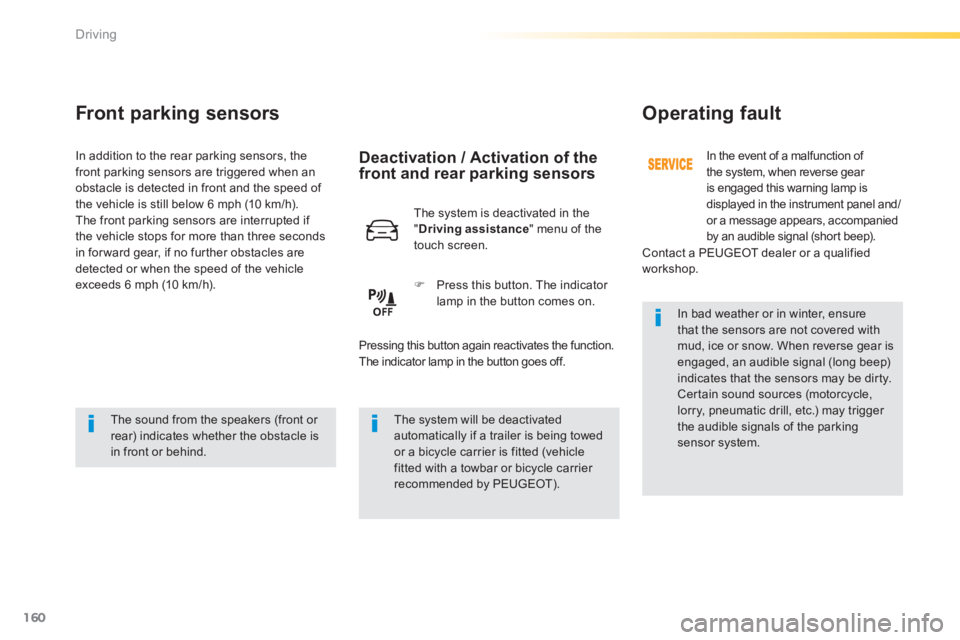
160
Driving
308_EN_CHAP04_CONDUITE_ED02-2013
Front parking sensors
The sound from the speakers (front or rear) indicates whether the obstacle is in front or behind.
The system will be deactivated automatically if a trailer is being towed or a bicycle carrier is fitted (vehicle fitted with a towbar or bicycle carrier recommended by PEUGEOT).
In bad weather or in winter, ensure that the sensors are not covered with mud, ice or snow. When reverse gear is engaged, an audible signal (long beep) indicates that the sensors may be dirty. Certain sound sources (motorcycle, lorry, pneumatic drill, etc.) may trigger the audible signals of the parking sensor system.
In addition to the rear parking sensors, the front parking sensors are triggered when an obstacle is detected in front and the speed of the vehicle is still below 6 mph (10 km/h). The front parking sensors are interrupted if the vehicle stops for more than three seconds in for ward gear, if no further obstacles are detected or when the speed of the vehicle exceeds 6 mph (10 km/h).
Deactivation / Activation of the front and rear parking sensors
Operating fault
In the event of a malfunction of the system, when reverse gear is engaged this warning lamp is displayed in the instrument panel and/or a message appears, accompanied by an audible signal (short beep).
Contact a PEUGEOT dealer or a qualified workshop.
The system is deactivated in the " Driving assistance " menu of the touch screen.
Press this button. The indicator lamp in the button comes on.
Pressing this button again reactivates the function. The indicator lamp in the button goes off.
Page 171 of 400
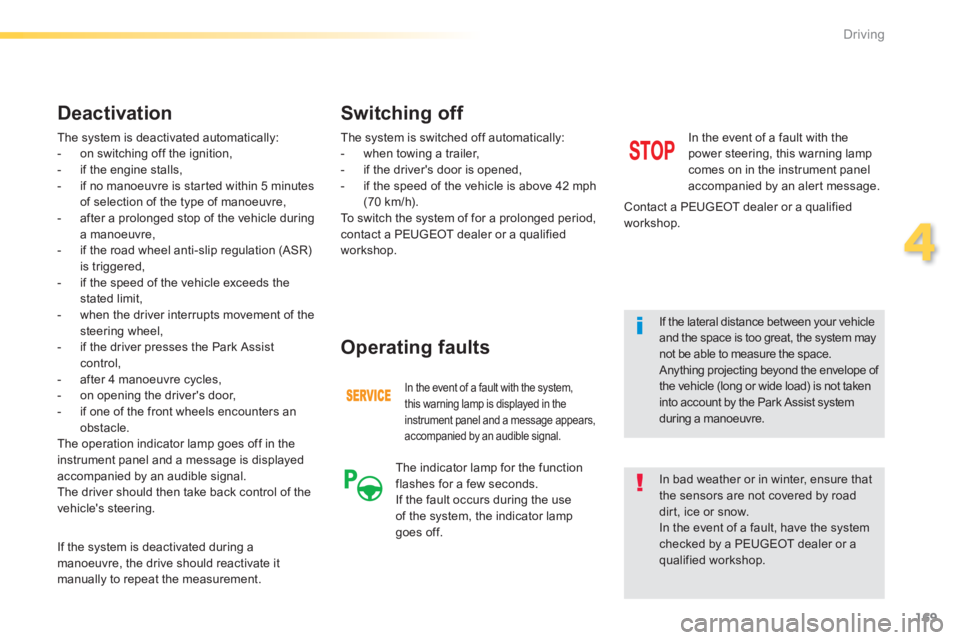
169
4
Driving
308_EN_CHAP04_CONDUITE_ED02-2013
The system is deactivated automatically: - on switching off the ignition, - if the engine stalls, - if no manoeuvre is started within 5 minutes of selection of the type of manoeuvre, - after a prolonged stop of the vehicle during a manoeuvre, - if the road wheel anti-slip regulation (ASR) is triggered, - if the speed of the vehicle exceeds the stated limit, - when the driver interrupts movement of the steering wheel, - if the driver presses the Park Assist control, - after 4 manoeuvre cycles, - on opening the driver's door, - if one of the front wheels encounters an obstacle.
The operation indicator lamp goes off in the instrument panel and a message is displayed accompanied by an audible signal. The driver should then take back control of the vehicle's steering.
Deactivation
If the system is deactivated during a manoeuvre, the drive should reactivate it manually to repeat the measurement.
The system is switched off automatically: - when towing a trailer, - if the driver's door is opened, - if the speed of the vehicle is above 42 mph (70 km/h). To switch the system of for a prolonged period, contact a PEUGEOT dealer or a qualified workshop.
In the event of a fault with the system, this warning lamp is displayed in the instrument panel and a message appears, accompanied by an audible signal.
Operating faults
In the event of a fault with the power steering, this warning lamp comes on in the instrument panel accompanied by an alert message.
Contact a PEUGEOT dealer or a qualified workshop.
Switching off
If the lateral distance between your vehicle and the space is too great, the system may not be able to measure the space. Anything projecting beyond the envelope of the vehicle (long or wide load) is not taken into account by the Park Assist system during a manoeuvre.
In bad weather or in winter, ensure that the sensors are not covered by road dirt, ice or snow. In the event of a fault, have the system checked by a PEUGEOT dealer or a qualified workshop.
The indicator lamp for the function flashes for a few seconds. If the fault occurs during the use of the system, the indicator lamp goes off.
Page 262 of 400
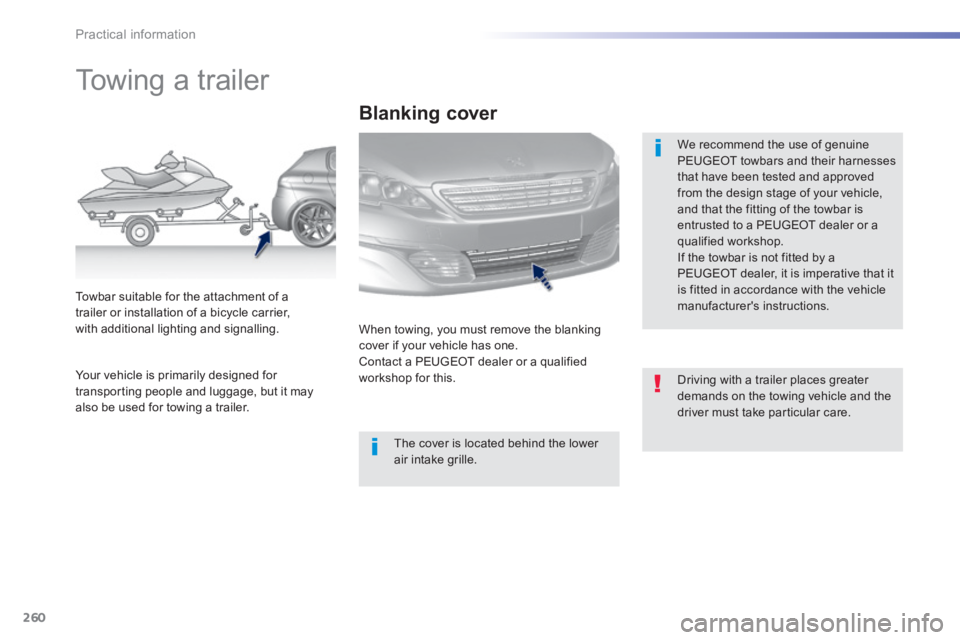
260
Practical information
308_EN_CHAP07_INFO PR ATIQUES_ED02-2013
Towing a trailer
We recommend the use of genuine PEUGEOT towbars and their harnesses that have been tested and approved from the design stage of your vehicle, and that the fitting of the towbar is
entrusted to a PEUGEOT dealer or a qualified workshop. If the towbar is not fitted by a PEUGEOT dealer, it is imperative that it is fitted in accordance with the vehicle manufacturer's instructions. Towbar suitable for the attachment of a trailer or installation of a bicycle carrier, with additional lighting and signalling.
Blanking cover
When towing, you must remove the blanking cover if your vehicle has one. Contact a PEUGEOT dealer or a qualified workshop for this. Driving with a trailer places greater demands on the towing vehicle and the driver must take particular care.
Your vehicle is primarily designed for transporting people and luggage, but it may also be used for towing a trailer.
The cover is located behind the lower air intake grille.
Page 263 of 400

261
7
Practical information
308_EN_CHAP07_INFO PR ATIQUES_ED02-2013
Driving advice
Distribution of loads
Distribute the load in the trailer so that the heaviest items are as close as possible to the axle and the nose weight approaches the maximum permitted without
exceeding it. Air density decreases with altitude, thus reducing engine performance. Above 1 000 metres, the maximum towed load must be reduced by 10 % for every 1 000 metres of altitude.
Side wind
Take into account the increased sensitivity to side wind.
Cooling
Towing a trailer on a slope increases the temperature of the coolant. As the fan is electrically controlled, its cooling capacity is not dependent on the engine speed.
To lower the engine speed, reduce your speed. The maximum towed load on a long incline depends on the gradient and the ambient temperature. In all cases, keep a check on the coolant temperature.
If the warning lamp and the STOP warning lamp come on, stop the vehicle and switch off the engine as soon as possible.
Braking
Towing a trailer increases the braking distance. To avoid overheating of the brakes on a long mountain type of descent, the use of engine braking is recommended.
Ty r e s
Check the tyre pressures of the towing vehicle and of the trailer, observing the recommended pressures.
Lighting
Check the electrical lighting and signalling on the trailer.
The rear parking sensors will be deactivated automatically if a genuine PEUGEOT towbar is used.
Refer to the "Technical data" section for details of the weights and towed loads which apply to your vehicle.
Page 287 of 400

285
9
Technical data
308_EN_CHAP09_CARACTERISTIQUES TECHNIQUES_ED02-2013
Weights and towed loads
The weights are given in the registration certificate for your vehicle and on the manufacturer's VIN plate. The information can also be obtained from PEUGEOT dealers and is included in the descriptive table of technical characteristics for the vehicle in sales brochures. The maximum type-approved trailer weight
varies according to market zone. In each country, you must comply with local legislation on towed loads.
For information on your vehicle's towing capabilities and its gross train weight, contact a PEUGEOT dealer.
Load transfer
If the towing vehicle has not reached the GV W, it is possible to transfer this weight to the trailer. The gross train weight and maximum trailer weight are valid up to an altitude of 1 000 metres; the maximum trailer weight specified must be reduced by 10 % for every additional 1 000 metres of altitude. In all cases, do not exceed the weight of the trailer and the GTW, indicated on your registration certificate. Observe the towing capacities of your vehicle.
The weight of a braked trailer with load transfer can be increased on condition that the equivalent weight is removed from the vehicle and the GTW is not exceeded. High ambient temperatures may result in a reduction in the per formance of the vehicle to protect the engine. If the ambient temperature is above 37 °C, limit the towed load to 700 kg, without any transfer of load. The speed of a towing vehicle must not exceed 60 mph (100 km/h) (comply with the legislation
in force in your country).
The recommended nose weight (weight on the
towbar ball) is 75 kg.
Engines
The values (engine capacity, net maximum power, power to weight ratio, engine speed, CO2 emissions, ...) are given in your vehicle's registration document. They can also be obtained from PEUGEOT dealers and are included in the descriptive table of technical characteristics for the vehicle in sales brochures.
For more information, contact a PEUGEOT dealer or a qualified workshop.